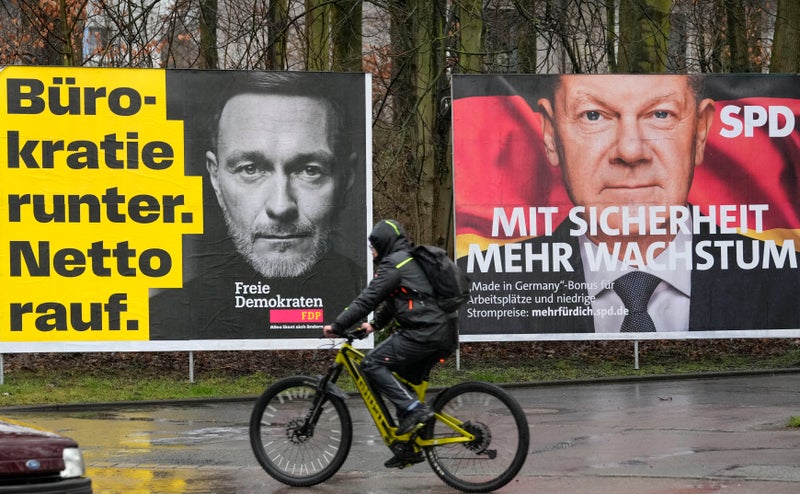A detailed look at the results reveals a divided nation increasingly drifting to fringes as dissatisfaction with mainstream parties mounts. German voters yearning for a steady hand in troubled times handed a clear victory to the conservative opposition leader Friedrich Merz in Sunday’s watershed election, punishing the centre-left-led alliance of Olaf Scholz.
But a closer look at the results of the snap election, triggered when Scholz’s government collapsed in acrimony in November, reveals a divided nation increasingly drifting to the fringes as dissatisfaction with the mainstream parties mounts. By almost any measure – young-old, east-west, rich-poor, urban-rural and female-male – the election laid bare stark differences among Germans about how they see their future in Europe and whom they trust to lead them.
The dramatic surge of the anti-migration, anti-Islam Alternative für Deutschland (AfD) sapped support from across the political spectrum to win one in five votes, but it will be excluded as a pariah party from any coalition negotiations. Merz’s centre-right CDU/CSU bloc and Scholz’s Social Democrats (SPD), severely weakened in this election, now look condemned to cooperate in a not-so-grand coalition government to keep the far right at bay. Merz has set an Easter target for a deal.
Merz’s conservative alliance turned in its second poorest performance since the second world war with just 29%. It was enough to soundly beat the AfD, however, which came in second on 21%. Together with the SPD on 16%, his coalition would have a wafer-thin majority of 328 seats in the 630-seat parliament.
But compared with many of his predecessors, including the unpopular Scholz, Merz has failed to convince many voters he has the right stuff to govern Germany. A poll by opinion research institute Infratest dimap showed that only 43% thought Merz was chancellor material, with just 35% approving of his work in politics to date. Scholz, by contrast, began his term in December 2021 with a 66% approval rating as he took over from veteran leader Angela Merkel, whom voters re-elected three times.
Analysts put the gap down to Merz’s more sharp-tongued, divisive style and his controversial decision to seek support from the AfD in January on hardline immigration-curbing measures before parliament. Critics said he was shattering a taboo while Merz had called his stance on migration “uncompromising” – something that might not bode well for the coalition talks ahead.
The far-left Linke, which was the most strident in condemning Merz’s risky gambit, pulled a surprising 8.8% – nearly twice their previous share. One look at the electoral map shows a Germany still divided. The ex-communist eastern states appear as a sea of blue representing direct mandates for the hard-right AfD, while the former West Germany is awash in CDU/CSU black dotted with flecks of red for the SPD and green for the ecologist Greens.
In eastern states such as Saxony and Brandenburg, the AfD was able to strongly improve on its 2021 result to capture about one-third of the vote, with boosts of nearly 13 points and more than 14 points respectively. In both regions, the AfD chapters have been classified by domestic security authorities as extremist organisations seeking to undermine the constitutional order.
Exit polls showed that across Germany, the party was able to poach support from across the political spectrum to achieve the strongest outcome for a far-right party since the Nazi period. The CDU/CSU was hit particularly hard, ceding more than 1 million voters across the country to the far right.
Germans under 35 have been expressing frustration with the mainstream parties at the ballot box for some time, capturing headlines during last June’s European elections when the AfD made big unexpected gains among first-time voters. Crime and immigration, street bullying, the soaring cost of housing and fears of military conscription if Germany goes to war all arise as issues driving younger Germans away from the centre.
At this election, in the 25-34 age bracket, the AfD came out on top with 22%, ahead of CDU/CSU on 18%, and the Greens and the far-left Linke at 16% each. The Linke, meanwhile, campaigned hard on a tax-the-rich message focused on fighting poverty and capping rents that appealed to the youngest voters.
The party, which also made effective use of social media platforms such as TikTok to ram home its anti-Merz message, won among the 18-24 set with 25% of the vote, ahead of the AfD at 21% and CDU/CSU on 13%. Germans 70 and up were most likely to reject the AfD, which won just 10% in that cohort.
In both the lagging east and the rust belts of the west, the AfD made particularly big strides among working-class voters – long seen as the Social Democrats’ key base. AfD support surged 17 points among workers to 38%, while the SPD haemorrhaged 14 points to land on just 12%.
A gender divide was also clearly visible, with women more likely to support left-leaning parties and men drawn to the right. The AfD, for example, won 23% of men but only 17% of women while the SPD and the Linke claimed 18% and 11% of women’s votes respectively, compared with 15% and 7% of men’s.































